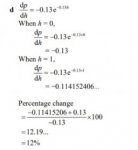Thanks! This was confusing me. If the question said 'rate of change' would this be ok?
I suppose; but I don't think anyone would actually ask that question. In particular, that is not what "the model predicts", as the question says, except in an indirect way, so they would have to change the whole question if they meant that. It is the answer that is wrong, not the question.
If by "model" they mean the given equation p = e^(-0.13h), that says that we have exponential decrease, which implies that the percentage decrease over a given distance is constant, something you have perhaps been taught about exponential models. The idea that the percentage change in rate of change is constant, is a secondary inference, not something you'd normally say it "predicts".
If by "model" they mean the differential equation, that more or less
directly says is that the rate of change in the
pressure relative to height (dp/dh) is proportional to the
pressure (p), so that the percentage change in pressure (change in pressure over pressure) is constant. That constant, in the limit, is k = -0.13 = 13% decrease. The percentage change over a kilometer is close to that, about 12.2%; if you did the calculation over a smaller change in height, it would approach 13% per km. For example, from h=0 to 0.1, p changes from p = e^(-0.13*0) = 1 to p = e^(-0.13*0.1) = 0.987, a percentage change of (0.987 - 1)/1 = -0.013 = -1.3%, which is -13% per km.

